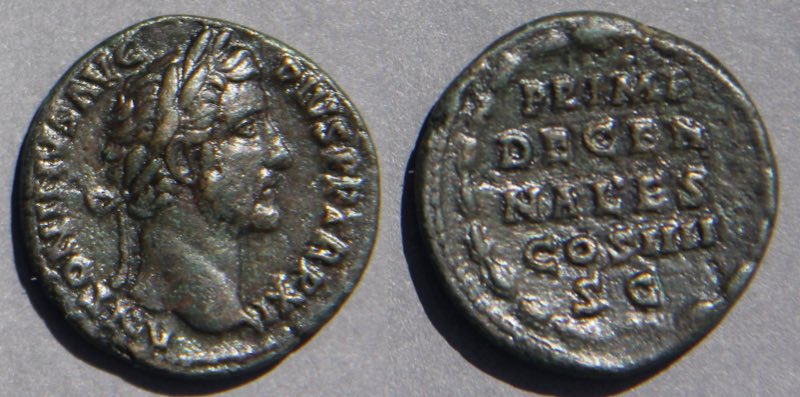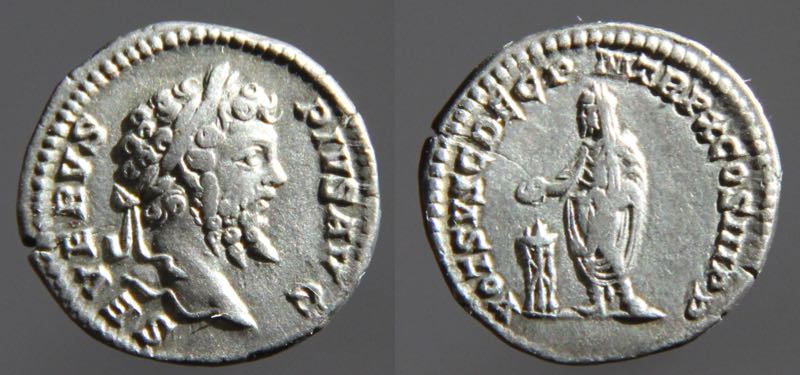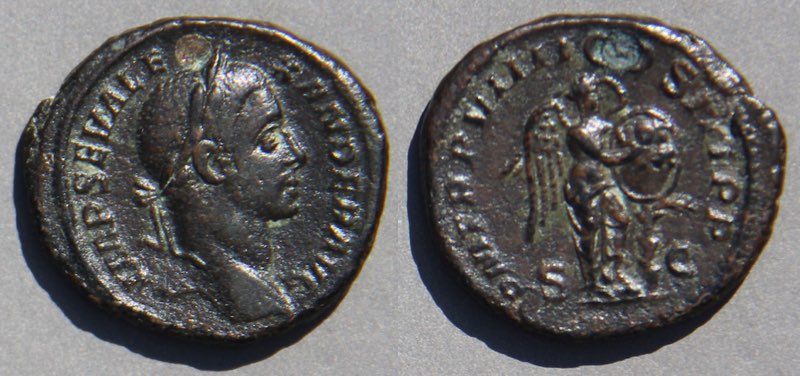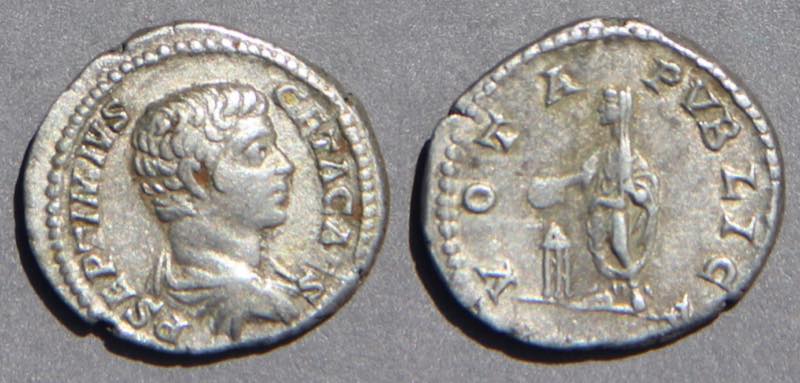Dating VOTA coins
There remain unanswered questions about vota ceremonies and about the princples for dating Roman coins that record vows. For example, consider vows for ten years, which were taken (suscepta) soon after becoming emperor.
Questions:
1) If the emperor made it to ten years, when were the ten-year ceremonies held? On the tenth anniversary? At the beginning of the tenth regnal year? After the tenth regnal year had been completed? (Regnal years begin in January. There are not many ancient sources that help answer those questions. One ancient document records a ceremony on January 3.
BMC IV page lxvi says "Celebration of the decennial vows normally began at the end of the ninth year--in this case July A.D. 147; celebration here [on coins of Anotninus Pius with TRP XI] is deferred until December of that year at the earliest--why we cannot say." This would be evidence for using regnal years as opposed to actual anniversaries.
2) If coins mention vows for ten years, when were the coins issued? In many cases we know coins were issued at the beginning of the reign (no matter the time of year) and the vows are recorded on coins must be suscepta (taken). However, in some second-century and early third-century cases we have vows for ten years on coins dated (by TRP numbers) to regnal years 9, 10 and 11, indicating the vows were soluta (paid, and renewed). Year-9 coins might have been issued in anticipation of (as an advertisement for?) the ceremony at which vows were to be paid. Whether the TRP X coins imply that the vows were already soluta during the tenth year because the vow ceremony was at the beginning of the tenth regnal year is uncertain. So, if the coins were not a beginning-of-the-reign suscepta issue, were they struck in anticipation of the event, right around the event, or after the event in commemoration of it?
3) If a ruler was Caesar and then Augustus, would his vows for ten years begin at the date he became Caesar, or date he became Augustus? For dated coins of Marcus Aurelius and Caracalla (below) the answer is "as Augustus," but it is not clear that is always the case.
Observations:
4) Vows can be taken (suscepta) or they can be paid (soluta). In the second century, most coins recording vows for ten years were issued near year 10 for vows paid at year 10. However, Pertinax and later emperors mentioned vows for 10 years on coins that were issued immediately upon becoming emperor and were therefore for vows taken.
5) In the middle of the third century most emperors with 10-year vota coins did not make it to ten years and the vota issues are small, so we infer that they were issued for a short while at the beginning of the reigns.
6) The rare small fractional vota folles issued at Trier under the tetrarchy are dated by Zschucke (who wrote the book, in German, on the series) to actual annversaries, not regnal years.
7) Vow recorded on coins were for 10 years or 20 years until years 5 and 15 appeared on coins minted under Constantine.
8) The common vota coins under Constantine are dated by RIC to dates which depend upon the mint (e.g. not all year-5 vota coins for Constantine II are given the same dates) and dates range from a few years before the event to the year of the event. (It almost seems the coins say "We are looking forward to year 5! [or 10 or 15 or 20 or 30])
9) The common vota coins under Magnentius (VOT V MVLT X) seem to have been issued from the beginning of the reign and continued throughout the reign. Those coins, as well as the vota types of Julian II and Jovian, must record vows suscepta (taken) and not are dated with reference to completion ceremonies.
10) If there were co-rulers, as in the fourth century, the numbered vows were appropriate for one of the co-rulers, but not necessarily the ruler on the coin.
Further Questions and Observations:
- Coins mentioning vows are rare under Augustus, non-existent after Augustus until Hadrian, and then uncommon in the second century, gradually becoming more frequent in the third century and under the tetrarchy. Then, under Constantine and later, VOTA types are very common.
- Apparently, the conversion to Christianity did not make vows obsolete, rather, at least for a time, vows were on a significantly higher fraction of coins.Vows were on a substantial fraction of the coinage after emperors became Christian (which seems counterintuitive given they were part of the pagan religion).
- If there were co-rulers, as in the fourth century, numbered vows were appropriate for one of the rulers, but not necessarily the one on the coin.
- If many coins of a ruler are VOTA types (in the second half of the fourth century), they may have been issued continuously, not only around the appropriate time for the ceremony.
- When legends mention two numbers (e.g. VOT V MVLT X), both are for vota suscepta (not the first soluta and the second suscepta) as demonstrated by numerous types of emperors who did not even make it to 5 years.
- Sometimes the date of a vota coin on other numismatic grounds seems incompatible with any explanation of how vows were commemorated on coins. How do we explain dates of types that on other numismatic grounds seem to belong to a year not suggested by the vota number?
- Under the tetrarchy the rare small fractional follis denominations (mostly from Trier) often record vota. Zschucke thought they were issued specifically for vota occasions which he thought were anniversaries.
- The silver siliqua denomination (4th century) often records vota. Given the scarcity of late Roman silver, it brings up the question for whether they were in some way related to vows.
Evidence:
Magnentius became Augustus 19 January 350 so his fifth year would have begun in January 354, but he didn't last that long-- only until to 18 August 353. Decentius was elevated in Spring 351 and issued the same type, so the numbers on his coins belong to Magnentius. In the second and third centuries vows mentioned ten years, but not five. It may be that all the short regins prompted emperors to think they should pay the gods more quickly lest the gods think protecting the emprors was too much work for a payoff delayed until the tenth year. If this type records, as seems likely, vows suscepta for both five and ten years at the beginning of the reign, it respects the traditional tenth-year vows and, in addition, promises an earlier payoff.
The Ceremony. A military calendar was uncovered at Dura Europos on the Euphrates river in Mesopotamia which records that January 3 was a holiday for "vows fulfilled and offered for the preservation of our lord Marcus Aurelius Severus Alexander Augustus and for the eternity of the Roman people" with sacrifices and prayers "to Jupiter, best and greatest, an ox; to Juno, a cow; to Minerva, a cow." [Wilken, p. 57]
The Oxford Classical Dictionary, Third Edition, says:
"In public votive religion it was the magistrate who in the name of the state undertook to offer to a god or gods sacrifices, games, the building of a temple or an altar etc., if the god on his side would give his assistance in such basic collective crises as war, epidemics, and drought. Formulas had to be pronounced in public and were very strict: mistakes required the repetition of the whole ceremony. In addition to these extraordinary vows there were also regular vota, pronounced for a definite period: e.g. the annually renewed vota of the magistrates for the welfare of the state on 1 January before the first regular sitting of the senate, and the vota at the termination of the lustrum. Such vows found their direct continuation under the empire in the vota pro salute imperatoris (for the health or safety of emperor and his family) and became periodical: vota quinquennalia, decennalia (for five, ten years). Extraordinary vows (for the safe return of the emperor from an expedition, for the recovery of the empress in cases of sudden illness) continued to exist into late antiquity. The text of the votum was officially fixed in the presence of the pontifices, and the document went into the archives."
Dating and Regnal Years. The first year of an emperor's reign, year 1, ended at the end of the calendar year, not after a full 365 days. So the first year might be quite short. Also, the final regnal year could be short or long, depending upon when the emperor died during the calendar year. Only the regnal years in between are full years. Theoretically it would be posible for a reign of 14 months to record three years--beginning near the end of one calendar year, continuing the following full year, and then including a small part of the third calendar year. In Rome, the calendar year begin January 1 and consulships begin Jan 1. (In Roman Egypt, where regnal year dating on the Egyptian calendar is the norm, the year began August 29, so a ruler like Domitius Domitianus (c. 295) in Alexandria had coins of year 2 but not year 1 because his regin began shortly before August 29 and he didn't have time to put year-1 coins into production.)
As numismatists, we hope the vota numbers on coins to tell us when the coins were minted. We expect the date of the vota festival was properly computed and the coins might be from that anniversary or perhaps a short while earlier in anticipation of the event or continued for a while afterward in commemoration of the event. Unfortunately, that is sometimes, especially under the later empire, not the case. Other numismatic considerations sometimes convince us that a vota issue was significantly earlier than the vow number would suggest.
Evidence for Dating. There is some question about whether vows for ten years were celebrated as soluta at the beginning of the tenth year (i.e. after nine years) of after the tenth year. Scholars have come down on both sides of this, and it is not clear the practice was always the same throughout the first five centuries. We can hope for evidence from ancient sources, but there is little other than from the coins themselves. We turn to coin evidence now.
 The Second Century. Antoninus Pius celebrated vows with "PRIMI DECENNALES" ("the first ten years") types. Here is a coin of Antoninus Pius (10 July 138 - 7 March 161). It is and as, 26 mm and 10.05 grams.
The Second Century. Antoninus Pius celebrated vows with "PRIMI DECENNALES" ("the first ten years") types. Here is a coin of Antoninus Pius (10 July 138 - 7 March 161). It is and as, 26 mm and 10.05 grams.
ANTONINVS AVG PIVS PP TRP XI (11th year)
PRIMI/DECEN/NALES/COS IIII/SC, in wreath.
Sear 4310. RIC 853a "147-8". BMC 1817.
This type has a date on it. TPR XI refers to the specific year 147/8 (Under Antoninus Pius the TRP number still changed on Dec. 10). This closely matches the "tenth year" (147, January 1 to the end)*. If this is right, the celebration of ten years was soluta and this type commemorates the occasion on which the vows were paid. It suggests the type was issued in commemoration after the event, not in anticipation of the event, and the event was after the tenth year, not at the begining of the tenth year.
* Sear (second edition) lists the dates of TRP numbers for Antioninus Pius and assigns both X and XI to 147/8, which is irregular. The years before and after are numbered in the normal sequence. He has TRP beginning December 10, 138 (not at the beginning of the reign in July) so TRP X would begin December 10, 147. I need to find out when the TRP numbers began to change on January 1 instead of December 10 (Sear's lists have it begin with Septimius Severus). If it were January 1, 148, TRP X would be very short (just part of December) and TRP XI would coincide with the calendar year 148. (But, then so would the following TRP numbers coincide with calendar years, and in Sear's list they do not.)

Marcus Aurelius, Caesar 141-161, Augustus 7 March 161-180.
Denarius.
IMP M ANTONINVS AVG TRP XXV
(year 25, which is Dec. 170- Dec. 171)
PRIMI/DECEN/NALES/COS/III
This coin mentions year 10 as Augustus, not since he became Caesar.
161 was year 1, so 170 was year 10. This coin was struck as or after the tenth year was concluding.
Next is another dated coin.
 This is the only dated VOTA type of Septimius Severus (April 13, 193-211). It has legend
This is the only dated VOTA type of Septimius Severus (April 13, 193-211). It has legend
VOT SVSC DEC PM TRP X COS III PP.
The "TRP X" allows us to date it to his tenth TRP year.
Although the office of the tribune and thus the title TRP on coins changed December 10 in the early empire, under Septimius Severus it coincided with calendar years and he took TRP at the beginning of his reign, so (unlike Antoninus Pius) his regnal years are exactly the corresponding TRP years. TRP II began on January 1, 194. That makes TRP X begin on January 1, 202. (Also, he became "COS III" at the beginning of 202 and never was COS IIII.)
RIC 172. BMC 388. Sear II 6391. Struck AD 202.
So how can this coin have
"VOT SVSC X"? "Vota suscepta X". This coin appears to be issued during the tenth year, not after the tenth year was completed. If it anticipates ten years being completed, wouldn't the ceremony be for vows soluta? Isn't the tenth year late to be mentioning vows taken (suscepta) for ten years? Is the depicted ceremony, like the first coin on this page, referring to the tenth year (about to be) completed and simutaneouly vows renewed (suscepta) for ten more years, totaling twenty? Maybe vows for the tenth year were at the beginning of the year and this coin suggests the tenth-year vows were completed and new vows were suscepta.
Maybe the vows were really not to be paid after "the completion of ten full years 10 years" or even "the completion of 10 regnal years." Maybe it was for "making it to (the eginning of) bthe tenth regnal year."
The Antoninus Pius as was issued with TRP XI and this one has TRP X and "SVSC".
 Septimius Severus, 193-211.
Septimius Severus, 193-211.
SEPT SEV AVG IMP XI PART MAX, laureate head right
Year 11.
VOTIS/DECEN/NALI/BVS in wreath
Denarius. 19-18 mm.
Sear 6396. RIC 520a. BMC 681 "Eastern mint, 198-202"
Year 11 suggest the coin commemorates the 10-year festival after its completion.
Caracalla issued in 217 several vota types for year XX that commemorate his Parthian victory. He became Augustus in 198, likely early in the year, so 217 was regnal year 20, his last year.
 Caracalla, 196-198 as Caesar and 198 to April 8, 217 as Augustus.
Caracalla, 196-198 as Caesar and 198 to April 8, 217 as Augustus.
Denarius. 19 mm.
Victory seated, holding shield inscribed
VO/XX
trophy before with two captives at feet
PM TRP XX COS IIII PP
Dated to 217, his 20th regnal year (as Augustus)
RIC 297e "S, 217"
Hill 1601 "R3" (very rare in hoards)
Sear II 6892
Here is a coin with "VOT X" and "TRP VIIII".
 Vows and Victory. Here is an as of Severus Alexander (222-235).
Vows and Victory. Here is an as of Severus Alexander (222-235).
26-24 mm. 11.094 grams. Holed and plugged at 12:00.
IMP SEV ALE-XANDER AVG, his laureate head right
victory inscribing VOT X on a shield.
PM TRP VIIII COS III PP, S C on either side low in the fields
"TRP VIIII" dates the coin to the ninth year of his reign as Augustus, 230, which corresponds to the tenth year of his elevation to Caesar sometime in 221. This supports the argument that vows were taken upon the initial elevation to Caesar and their fulfillment was commemorated on coins of the tenth year.
RIC 506. Sear 8083.
 Geta (198-209-212)
Geta (198-209-212)
VOTA PVBLICA, Geta sacrificing, veiled, holding patera and roll.
RIC 57 "203-208". Hill 761 "205". Sear II 7207 obv. legend variety.
How can a coin like this be dated? One might date it by the protrait and apparent age of the young emperor. The obverse legends change throughout the reign and can be put in sequence and some coins might help date them. One might try to date it using vows for ten years soluta (as Caesar).
Dating vota coins is a project in progress.
Return to the main page on vota coins.
Leave the vota pages and go to the Table of Contents of this whole educational site.
 The Second Century. Antoninus Pius celebrated vows with "PRIMI DECENNALES" ("the first ten years") types. Here is a coin of Antoninus Pius (10 July 138 - 7 March 161). It is and as, 26 mm and 10.05 grams.
The Second Century. Antoninus Pius celebrated vows with "PRIMI DECENNALES" ("the first ten years") types. Here is a coin of Antoninus Pius (10 July 138 - 7 March 161). It is and as, 26 mm and 10.05 grams.
 This is the only dated VOTA type of Septimius Severus (April 13, 193-211). It has legend
This is the only dated VOTA type of Septimius Severus (April 13, 193-211). It has legend Septimius Severus, 193-211.
Septimius Severus, 193-211. Caracalla, 196-198 as Caesar and 198 to April 8, 217 as Augustus.
Caracalla, 196-198 as Caesar and 198 to April 8, 217 as Augustus. Vows and Victory. Here is an as of Severus Alexander (222-235).
Vows and Victory. Here is an as of Severus Alexander (222-235). Geta (198-209-212)
Geta (198-209-212)